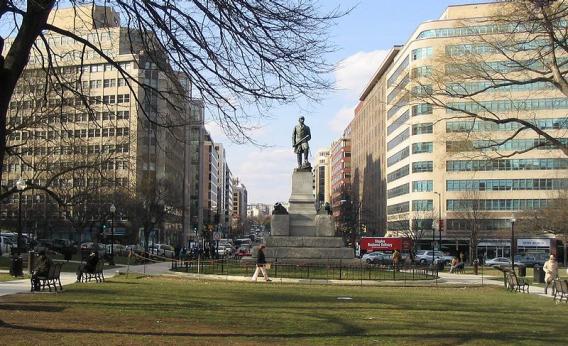A Wall Street Journal article on the continuing debate over whether DC would benefit from buildings taller than 130 feet concludes with a spokesman for the status quo explaining that there’s no need to increase the square footage of office space in the central business district since “developers have the option of rebuilding aging buildings or building in nearby office districts outside city limits with less-restrictive height limits.”
The renovations issue is a red herring as the issue here is the total supply of office space. Meanwhile, though it’s true you could put the buildings someplace else instead this misses the basic reason that cities and central business districts exist in the first place. People benefit from clustering together with other workers who are toiling in related first. Downtown Washington, DC contains the Congress, the Supreme Court, a major federal appeals court, the White House, and a host of regulatory agencies. That’s a critical cluster of activity that people in the “telling the world about what’s happening in the American government” and in the “helping the world influence what happens in the American government” want to be close to. And the people in those sectors want to be close to each other. It’s easier to meet for lunch or a drink after work to casually trade ideas, easier to attend a conference or a meeting, and more likely you’ll encounter an acquaintance by chance if you’re in the hub of activity. And this is one of the primary reasons why hubs of activity exist. If arbitrary locations were all equally good places to locate a firm, then you wouldn’t see downtowns at all. But you do see them—everywhere—and when you make it impossible for more stuff to fit downtown you don’t just displace activity elsewhere you reduce the total amount of activity.
There are also substantial efficiencies in terms of the provision of secondary services to offices and office workers. That’s your restaurants and dry cleaners but also repairmen and office supplies and so forth. When you have a rich concentration of offices and office workers, you can have a deep supply of local secondary services. A large market with lots of specialization and high productivity.
Meanwhile in practice terms, transportation networks just can’t serve everyplace. MetroRail makes connections at Gallery Place, L’Enfant Plaza, and Metro Center. MARC goes to Union Station, VRE goes to L’Enfant Plaza. The highways from the suburbs go to downtown. Insofar as jobs are located downtown, people who live in all sorts of different places can switch jobs without ruining their commutes.
None of that is to say that it’s necessarily inconceivable that the region should pay a heavy economic price for the aesthetic value of short buildings. Sometimes this is the kind of tradeoff you want to make. I don’t think we should pave over the National Mall, for example. But in the case of DC’s central business district, it seems to me that there’s a consistent failure to acknowledge that the economic price is very real and very large—billions of dollars—perhaps because it’s difficult to mount a persuasive case that the aesthetic values at stake here are actually all that wonderful.
